15 Things To Use When You're Out Of Pasta Sauce
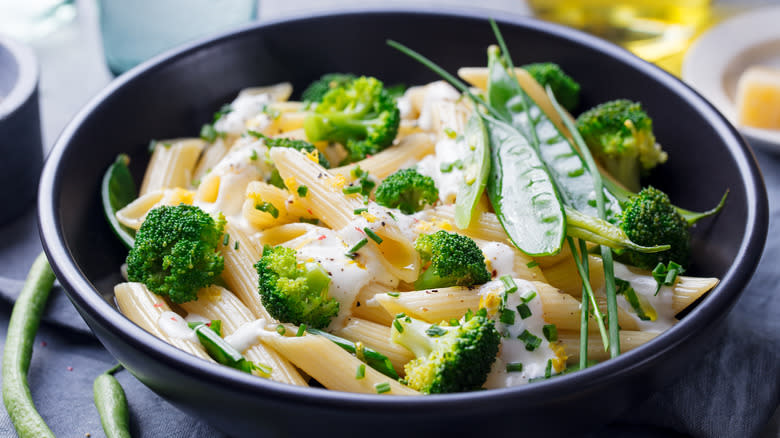
Just because you are out of spaghetti sauce does not mean you cannot have a simple, delicious pasta meal for dinner. Being out of pasta sauce may open the door to a world of pasta possibilities that you have never considered before. There are plenty of ways to upgrade your pasta without sauce, and we're here to help you with fresh ideas for your pasta night.
From the most basic of ingredients, like butter and olive oil, to more inventive and transformative hacks, these tips and tricks will transform the way you look at pasta. Most of these ideas are quite simple -- some take little more effort than simply opening a jar of pasta sauce and boiling some noodles. Plus there is always room for exploration, and all of these tips can be adjusted to your personal taste. Here are 13 ideas for how to make a delicious pasta meal, no pasta sauce needed!
Read more: Ingredients To Take Your Scrambled Eggs To The Next Level
Butter
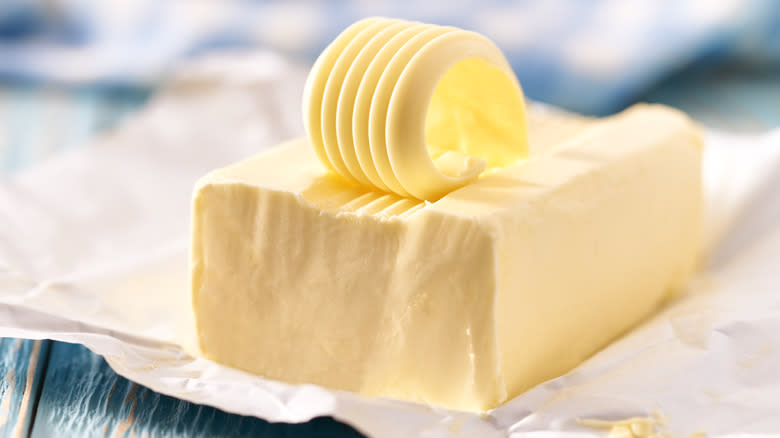
While butter noodles may just be the most basic, delicious meal, loved by foodie aficionados and picky children alike, we often forget about its existence in our adult age. The fact of the matter is, if you are low on ingredients, all you need for a delicious meal is pasta, butter, and some salt. It's incredibly simple, takes almost no time at all, and requires even less effort. Simply boil your noodles in salty water to your desired done-ness, drain them, and add butter and salt to your preference.
If you are feeling fancy, there are certain ways to spice up even this simple meal. For example, you can brown the butter for a brown-butter pasta. You can also cook down your butter with a variety of fresh herbs like parsley, thyme, or sage, for an easy, delicious, and herbaceous meal. These simple examples just go to show that there are hundreds of ways to make buttered noodles – just don't forget the butter!
Garlic And Olive Oil
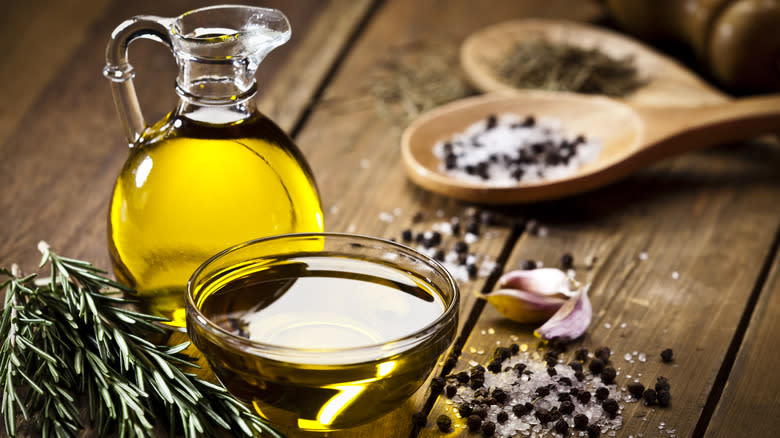
Another incredibly simple way to elevate your plain noodles is to add garlic and olive oil. Oil is an important addition to pasta, as it prevents the noodles from sticking together and adds a sauce-like component, even when you don't have any sauce on hand. As for the garlic -- well, garlic makes just about everything taste better.
While this might sound almost too simple, this ingredient combination is actually an official Italian dish with a name. Aglio e olio, which translates into garlic and oil, is a deliciously simple, sauceless pasta dish that dates back to the 1800s. This dish likely originates in Naples, and only takes about 15 minutes to make. As with butter noodles, there are endless ways to zhuzh up your garlic and olive oil pasta. In this simple aglio e olio recipe, for example, recipe developer Kate Shungu adds red pepper flakes for some kick and lemon zest for a pleasant, citrusy zip.
Parmesan Or Pecorino Romano
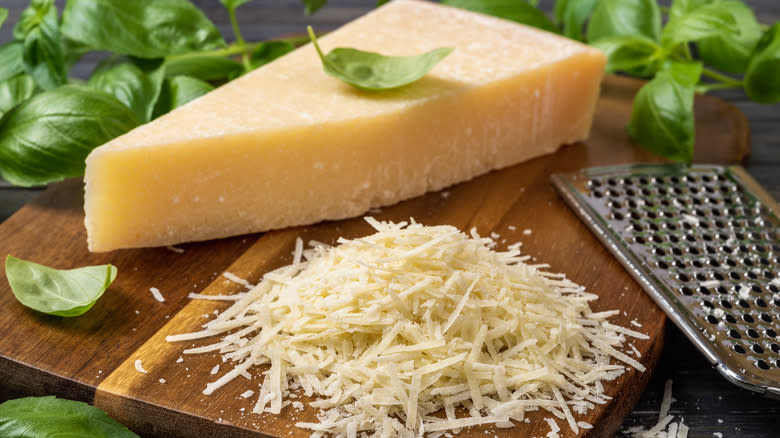
From spaghetti to carbonara, grated Parmesan might just be the single most classic ingredient to add to pasta. That, or Pecorino Romano, is a very suitable alternative which just happens to be former Food Network chef Giada De Laurentiis' favorite way to top pasta. The fact of the matter is, while we are so used to topping our pasta dishes with cheese, we often fail to consider that Parmesan cheese can be used on its own, in combination with oil or butter, to make a delicious pasta dish in a pinch.
De Laurentiis has some advice when it comes to simple dishes like this, which is to "always use quality ingredients," according to an exclusive interview with Tasting Table. This means that you should use high-quality cheese, and good pasta, as well as any other ingredient you might be tossing in, like olive oil, butter, or even salt. With high-quality ingredients, there is no reason that a cheesy, Pecorino Romano or Parmesan-coated pasta shouldn't be a gourmet meal.
Fresh Vegetables
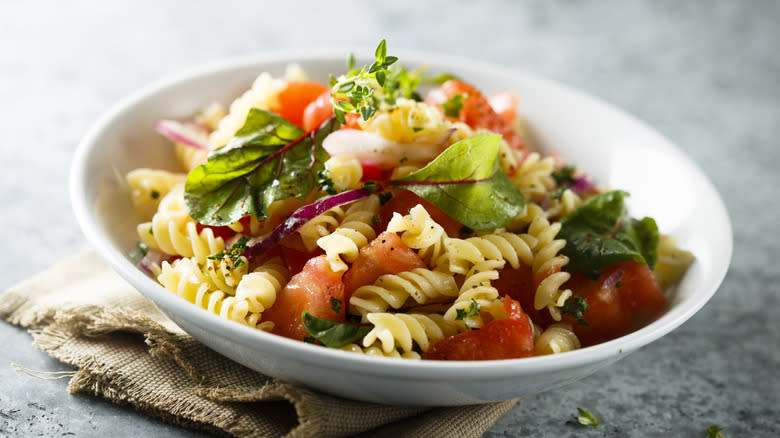
Adding fresh vegetables to your pasta can completely transform the dish from a plain, boring carb to a colorful, nutritious meal. Because vegetables provide a different texture to pasta, and because almost every vegetable has a succulent, juicy quality when cooked properly, adding veggies to your pasta often means you don't even need a real sauce. The most incredible thing about this hack is that the options are endless, depending on your flavor preferences and what vegetables you have on hand.
With onions and mushrooms, for example, you can make a simple and delightful mushroom and onion penne. The meatiness of the mushrooms and the flavor of the onions come together to create a truly easy -- but still very satisfying -- meal. If it is summertime, you can take all the summer veggies you have on hand and toss them in for fresh, summery pasta. You can use the vegetables in your fridge to inspire different flavor combinations. The best thing? All you need is your vegetables, some olive oil, salt and pepper.
Make Cacio E Pepe With Butter, Pepper, And Cheese
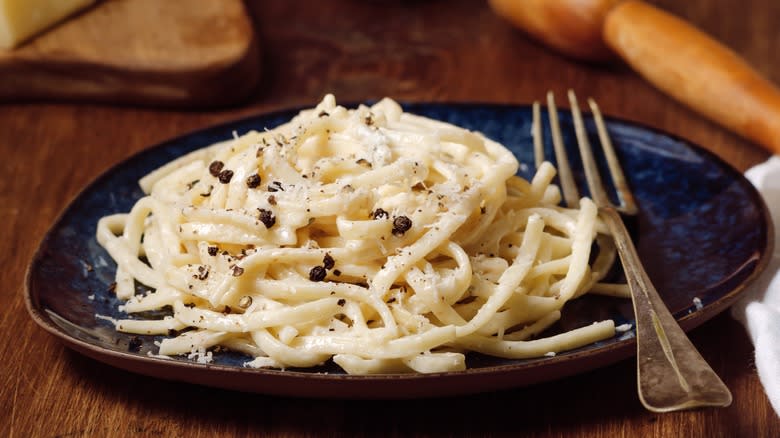
Another classic Italian dish that is as simple to make as it is delicious to eat is cacio e pepe. This dish, its name meaning "cheese and black pepper," uses just those two ingredients to make a delicious, creamy dish without the necessity of a pre-made sauce. Cacio e pepe, which uses Pecorino Romano instead of Parmesan, finds its roots in pastoral Italy during the 18th and 19th centuries.
Other than cheese and pepper, the only ingredients that cacio e pepe calls for are pasta and a little bit of pasta water; the salted pasta water and the nutty cheese marry together to create a deliciously creamy sauce for the pasta, while the black pepper saturated the dish for a spicy kick. A simple cacio e pepe recipe only takes 10 minutes, making it one of the quickest and easiest Italian meals out there.
Lemon
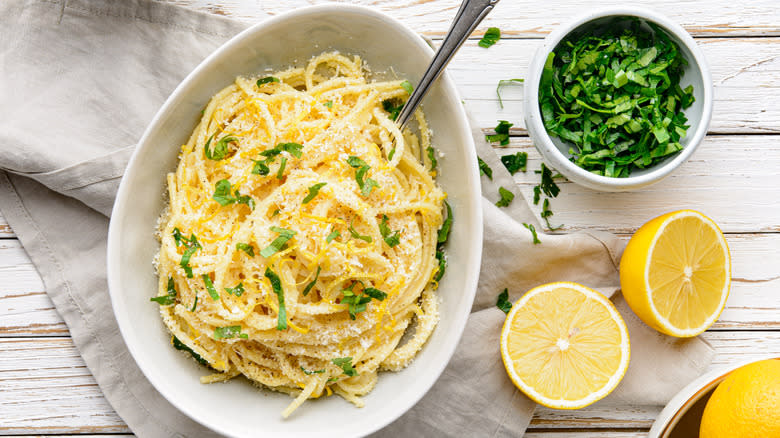
Lemon is one of those magical ingredients that can magically change the flavor profile of a dish. The addition of lemon juice or zest adds a beautiful pop of citrus, but moreover, it can add nuance and even alter how much salt is needed in your food. Even adding just a little bit, so that the actual flavor of the lemon can't be detected, can change the flavor profile of a dish and give it that perfect je ne sais quoi. This special transformation occurs because acidity, and especially lemon, added at the end of cooking, can bring different flavors into focus.
This is why adding lemon to your pasta, even just in addition to olive oil and salt, can be a huge game changer. This creamy lemon pasta is a great example of how lemon can be used to enhance a very basic pasta dish. It uses lemon, cream, Parmesan, and garlic to create a well-balanced symphony of flavors – no jarred pasta sauce necessary.
Use Butternut Squash And Cashews To Make A Faux Mac-And-Cheese
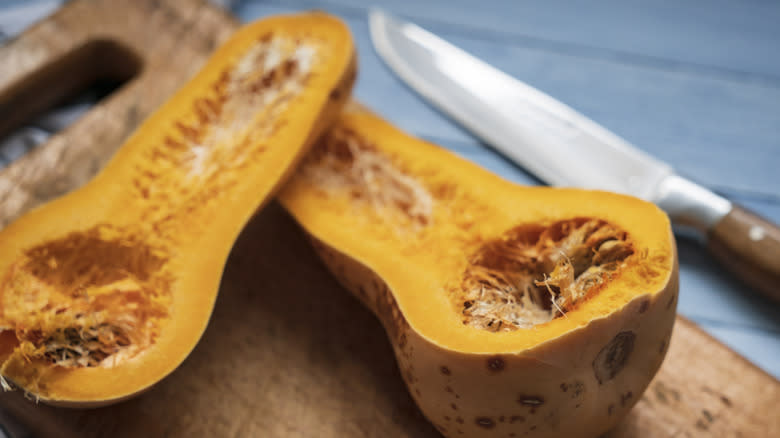
If what you're craving is cheesy, delicious pasta, but either you don't eat cheese, you don't have it on hand, or you simply can't be bothered to make a cheese sauce, then try making a sauce with butternut squash and cashews. The cashews bring a cheesy, nutty element while butternut squash is creamy and rich in this flavor combination that vegan pasta lovers have been swearing by for years.
This dish is not only nutritious and filling, but it also hides the butternut squash in the sauce, which means that even picky eaters are bound to love it. Even without the cashews, butternut squash makes a great creamy pasta sauce. This idea means that with just a little time and effort, you can make yourself a delicious pasta sauce out of ingredients you may never have expected. You may even find that you prefer this dish to a traditional macaroni and cheese.
Fresh Tomato And Basil
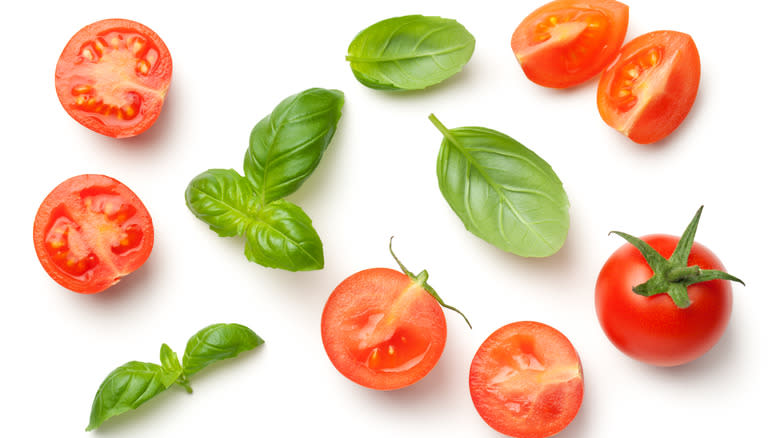
Fresh tomatoes, basil, and mozzarella are synonymous with summer, especially when combined in a caprese salad. The acidity of the tomato, the freshness of the basil, and the creaminess of the mozzarella work together magically. Why not try making pasta with these ingredients? Tomato and basil are a classic combination and work well in pasta as well as in salad. To make things even better, you can add mozzarella. If you are looking for a different flavor profile, feta cheese also works very well with tomato, basil, and pasta.
Adding pasta to any simple salad recipe is a great way to create a delicious, healthy, and filling meal that is full of both healthy carbs and veggies. While a caprese-inspired pasta dish is a great example, this is a flexible recipe. Depending on the ingredients that you have on hand, you may have many herb or vegetable combinations to pair with pasta.
Salad Dressing
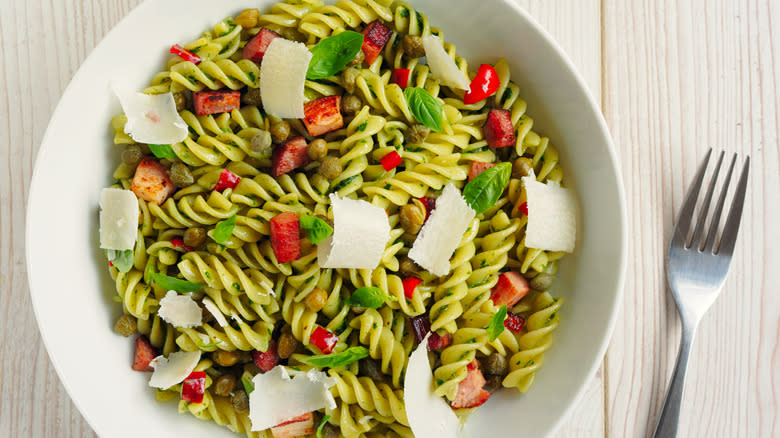
Salad dressing on pasta may not sound great at first blush, but if you think about it more, it makes a lot of sense. When you think of pasta salad, you may think of a mayonnaise-filled mess just sitting out in the summer heat, but there are many lighter ways to make pasta salad with a more traditional salad dressing that is quite delicious. For example, you can try adding kale and Caesar dressing to your pasta for a kale Caesar pasta salad that is just as delicious as it sounds.
You can also make pasta salad with fresh veggies like cucumber, tomato, feta cheese, and a vinaigrette for a delicious Mediterranean pasta salad. The options are truly endless – depending on what salad dressings you have in your refrigerator, you can experiment with different options. There are also many tips and tricks to making a great pasta salad, such as dressing your pasta immediately after it is cooked. This allows the salad dressing to soak into the pasta and imbue it with flavor.
White Wine
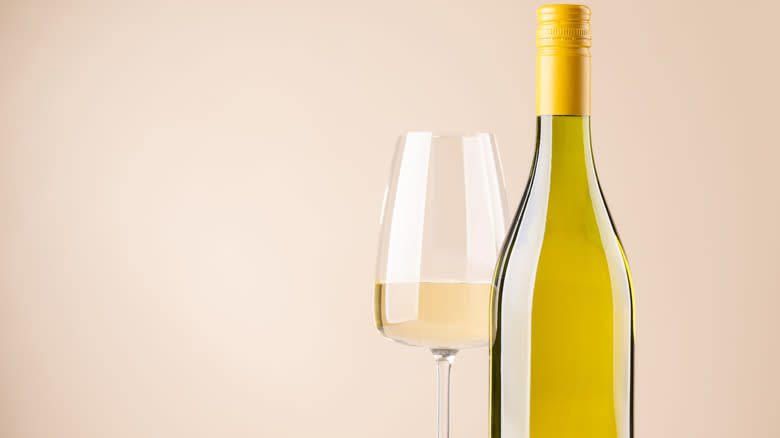
Cooking with wine can be a little bit daunting, especially if you are not used to it, but it is quite a simple task. Chef Alex Guarnaschelli spoke to Food and Wine about cooking with wine, giving some insight into the process. The chef says, "It's great for adding acidity to rich dishes. It's a lot like adding vinegar to olive oil when you're making a vinaigrette." It is important to let the wine cook down, because otherwise, Guarnaschelli warns, "the wine ends up tasting raw."
White wine is a great contrast to rich butter and pasta. The wine cooked down with butter can make a delicious pasta sauce, whether you are in a pinch or not. Simply cook down your onions, shallots, or garlic, then add your wine to deglaze the pan. When the wine is cooked down and the alcohol has evaporated, add in several pats of butter so that the sauce thickens and becomes delectably creamy, and voilà! You have a delicious, three-ingredient pasta sauce. Add your pasta and top with Parmesan, and you have a gourmet pasta dish ready in minutes.
Ricotta
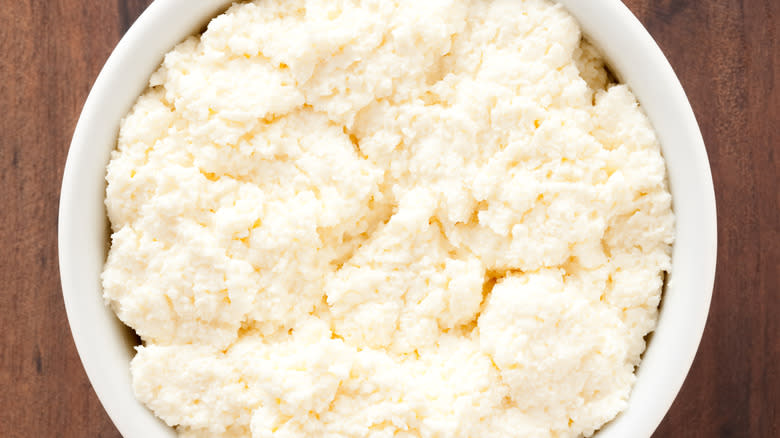
If you would like a creamy, rich pasta dish and you don't have any pasta sauce on hand, look no further than trusty ricotta. This soft, creamy cheese has been a staple in Italian cooking for generations. Thought to have been invented in Sicily in the 9th century, this ingredient has been around for a long time. It is made from whey, which is the liquid product left over after making other cheeses (such as mozzarella). It is a staple ingredient in lasagna.
There are many ways to use ricotta in your pasta dishes. The simplest, of course, is simply to pour it over your pasta with some salt and maybe some Parmesan and call it a day. This, in itself, would make a delicious meal. You can also play around with ricotta, however, and make more complex meals such as a creamy lemon ricotta pasta for an extra kick of zest.
Eggs
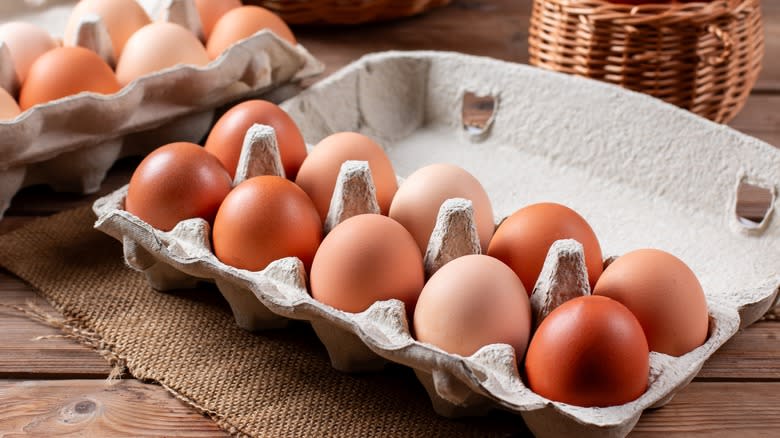
Eggs? In pasta? It might sound a little strange, but that is exactly what pasta carbonara is. The fact is, eggs can make an excellent pasta sauce, especially if you are low on ingredients.
While pasta carbonara's origins are somewhat debated, it is most closely associated with Rome today. The dish is made up of raw eggs mixed with Parmesan and seasoning – the eggs are cooked when they are combined with the hot pasta, coating the noodles in a deliciously creamy sauce. The meal is traditionally also made with bacon. Although adding the eggs to the pasta can be a little bit finicky, as you don't want the eggs to scramble, it is otherwise a very simple dish to make.
And while the most classic version of the dish is made with bacon, you can add any number of other ingredients to make your dish unique. For a vegetarian version, replace the bacon with mushrooms. If you want something a little more green, you can always add peas or spinach to make a more nutritious version of carbonara.
Olives
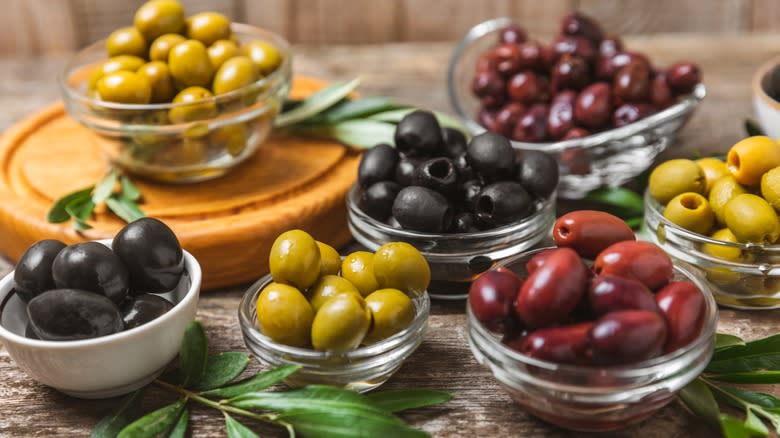
Olives are one of those controversial ingredients that people either love or hate. Still, most people who like olives pretty much only eat them as they come in the jar. Whether they are consumed as part of a snack, on a cheese board, or in a cocktail, we usually don't think of cooking olives. When cooked, however, olives can be transformed into a delicious, meaty, and salty element to add to your dish. Olives are full of healthy fats, which means that when they are cooked in a pan, they release their oils and become incredibly fragrant.
Whether you have pasta sauce or not, olives can be a great addition to your noodles. For example, olives added to spaghetti sauce add a meaty, umami flavor. If you don't have any sauce on hand, however, there are many ways to transform your pasta with the addition of olives. For example, try sautéeing olives in butter for a simple, salty, and rich sauce to coat your noodles.
Pasta Water
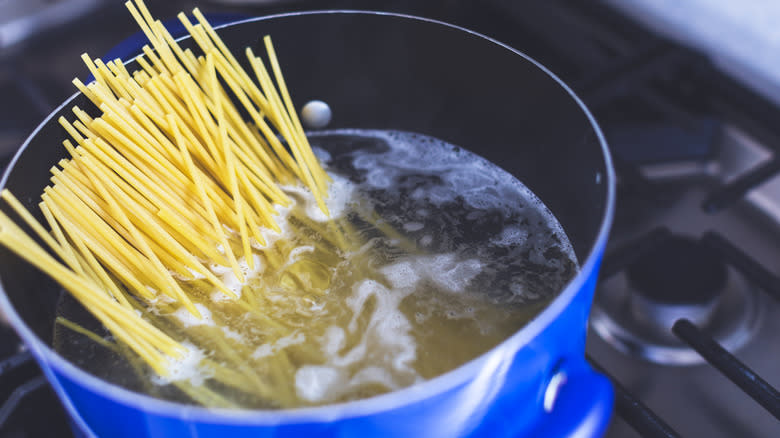
This might sound rather obvious. Or maybe you've never heard of putting pasta water into your pasta. Either way, you can never underestimate the value that some salty, starchy pasta water can add to your finished pasta dish. Pasta water is a super common ingredient in simple, homemade pasta sauces, because it is so versatile and easy to use, and you always have it available when you are making pasta.
Pasta water can be combined in a pan with ingredients like cream, Parmesan, lemon, and even herbs and spices. When combined with a cheese such as Parmesan, the starch in the water causes the sauce to thicken, creating a rich, creamy sauce that could not be easier to make. To use your pasta water, make sure that your boiling water is heavily salted before you add your noodles – this will improve the flavor of both your pasta and the sauce itself. Before you drain your noodles, use a cup to separate some of the water. Then, simply add your pasta water to some butter, Parmesan, and lemon -- or whatever other ingredients suit your fancy -- and you have an incredibly easy, delicious pasta sauce.
Miso Paste
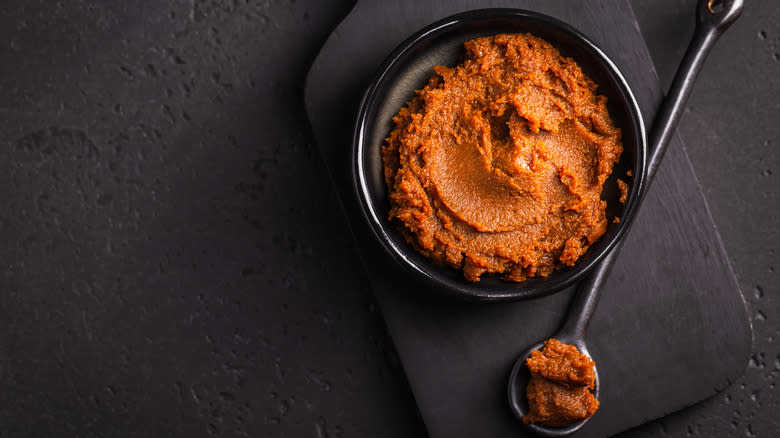
Miso has been rising in popularity over the past several years, but did you know that it is a great addition to pasta? Miso, which is fermented soybean paste, is made up of only three ingredients – soybeans, salt, and koji (a type of fungus grown on rice). It provides an earthy, salty, umami flavor that is a staple of Japanese cooking. Miso is incredibly versatile, however, and can make a great addition to any easy noodles.
Ayo Edebiri learned how to make a simple miso-butter pasta while she was preparing to play a chef in the hit show "The Bear." In addition to miso, this dish also included ingredients like butter, bread crumbs, armesan, lemon, and furikake (furikake is a Japanese seasoning made of ingredients such as sesame seeds, nori, and dried fish). While some of Edebiri's ingredients are a little bit more specialized, this dish can also be made more simply, such as by mixing miso, browned butter, and lemon in a pan and then stirring in your pasta.
Read the original article on Mashed


